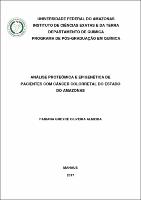| ???jsp.display-item.social.title??? |


|
Please use this identifier to cite or link to this item:
https://tede.ufam.edu.br/handle/tede/5766Full metadata record
| DC Field | Value | Language |
|---|---|---|
| dc.creator | Almeida, Fabiana Greyce Oliveira | - |
| dc.creator.Lattes | http://lattes.cnpq.br/8643360730620783 | por |
| dc.contributor.advisor1 | Souza, Afonso Duarte Leão de | - |
| dc.contributor.advisor1Lattes | http://lattes.cnpq.br/5784405197320526 | por |
| dc.contributor.advisor-co1 | Carvalho, Juliana de Saldanha da Gama Fischer | - |
| dc.contributor.advisor-co1Lattes | http://lattes.cnpq.br/1815083049778049 | por |
| dc.date.issued | 2017-02-17 | - |
| dc.identifier.citation | ALMEIDA, Fabiana Greyce Oliveira. Análise proteômica e epigenética de pacientes com câncer colorretal do estado do Amazonas. 2017. 152 f. Tese (Doutorado em Química) - Universidade Federal do Amazonas, Manaus, 2017. | por |
| dc.identifier.uri | http://tede.ufam.edu.br/handle/tede/5766 | - |
| dc.description.resumo | O câncer colorretal (CCR) é o terceiro tipo de câncer mais comum no mundo, com uma baixa taxa de sobrevivência e eficiência terapêutica. Um dos tratamentos é aretirada do tumor, que implica na remoção de um tecido aparentemente não tumoral ao redor do tumor (margem de ressecção). Nesse sentido, a margem de ressecção é uma região muito interessante para investigar as características moleculares do processo tumorigênico.Dessa forma, o objetivo desse trabalho foi realizar um estudo comparativo de amostras de tecidos tumorais e margem de ressecção através de análises epigenéticas e proteômicas de pacientes com câncer colorretal do estado do Amazonas (Brasil). Para o perfil epigenético, treze amostras, nas quais seis eram tumorais e sete eram margem de ressecção foram analisadaspela reação em cadeiadapolimerase (PCR) específica para metilação (MSP).Na análise proteômica,quatro amostras de CCR e suas respectivas margens de ressecçãoforam digeridas com tripsina, marcadas comiTRAQ 8-plex e submetidas a cromatografiadetroca catiônica forte. Cada fração foi analisada por cromatografia de fase reversa acoplada a um espectrômetro de massa Orbitrap Velos e, por fim, os dados foram analisados no programaPatternLab for Proteomics. A análise da metilação dos genes CDH1, CDKN2A, DAPK e TIMP2foi 30,8% (4/13), 30,8% (4/13), 84,6% (11/13) e 11/13 (84,6%), respectivamente.A análise proteômica identificou 1090 proteínas, das quais 56 foram apontadas como diferencialmente abundantes. Estas proteínas estão envolvidas principalmente no metabolismo energético (e.g.proteína S100A11 de ligação de cálcio),migração de células (e.g. transgelina), formação do citoesqueleto (e.g.profilina1) e participam de importantes processos biológicos (e.g.anidrase carbônica 2). A análise doGeneOntologyfeita para todas as proteínas identificadas revelou a relação dessas com processos de adesão, invasão, metástase e morte celular.Osresultados mostram padrões de metilação distintos para cada paciente que, por sua vez, podem contribuir no desenvolvimento de tratamentos individualizados e também proteínas diferencialmente abundantesrelacionadas àtumorigênese, enfatizando a importância do estudo de painéis de marcadores para o CCR no contexto das diferentes populações. | por |
| dc.description.abstract | Colorectal cancer (CRC) is the third most common cancer in the world, with a low survival rate and therapeutic efficacy. One of the treatments is tumor removal, which involves removal of apparently non-tumorous tissue around the tumor (resection margin). In this sense, the margin of resection is a very interesting region to investigate the molecular characteristics of the tumorigenic process. Thus, the objective of this study was to perform a comparative study of tumor tissue samples and margin of resection through epigenetic and proteomic analyzes of patients with colorectal cancer in the state of Amazonas (Brazil). For the epigenetic profile thirteen samples, in which six were tumoral and seven were resection margins were analyzed by polymerase chain reaction (PCR) specific for methylation (MSP). In the proteomic analysis, four CRC samples and their respective resection margins were digested with trypsin, labeled with iTRAQ 8-plex and subjected to strong cation exchange chromatography. Each fraction was analyzed by reverse phase chromatography coupled to an Orbitrap Velos mass spectrometer and, finally, the data were analyzed in the PatternLab for Proteomics program. Analysis of CDH1, CDKN2A, DAPK and TIMP2 genes was 4/14 (30.8%), 5/14 (30.8%), 11/14 (84.6%) and 12/14 (84.6%), respectively. Proteomic analysis identified 1090 proteins, of which 56 were identified as differentially abundant. These proteins are mainly involved in energy metabolism (e.g., S100 calcium binding protein A11), cell migration (e.g. transgelin), cytoskeleton formation (e.g., profilin 1) and extracellular matrix degradation (e.g., carbonic anhydrase 2). Gene Ontology analysis revealed several proteins related to adhesion, invasion, metastasis and cell death. The results show distinct methylation patterns for each patient, which in turn may contribute to the development of individualized treatments andalso differentially abundant proteins related to tumorigenesis, emphasizing the importance of the study of marker panels for CRC in the context of different Populations. | eng |
| dc.description.sponsorship | CNPq - Conselho Nacional de Desenvolvimento Científico e Tecnológico | por |
| dc.format | application/pdf | * |
| dc.thumbnail.url | http://tede.ufam.edu.br//retrieve/17306/Tese%20-%20Fabiana%20G.%20O.%20Almeida.pdf.jpg | * |
| dc.language | por | por |
| dc.publisher | Universidade Federal do Amazonas | por |
| dc.publisher.department | Instituto de Ciências Exatas | por |
| dc.publisher.country | Brasil | por |
| dc.publisher.initials | UFAM | por |
| dc.publisher.program | Programa de Pós-graduação em Química | por |
| dc.rights | Acesso Aberto | por |
| dc.rights.uri | http://creativecommons.org/licenses/by-nc-nd/4.0/ | - |
| dc.subject | Câncer colorretal | por |
| dc.subject | Epigenética | por |
| dc.subject | Proteômica | por |
| dc.subject.cnpq | CIÊNCIAS EXATAS E DA TERRA: QUÍMICA | por |
| dc.title | Análise proteômica e epigenética de pacientes com câncer colorretal do estado do Amazonas | por |
| dc.type | Tese | por |
| Appears in Collections: | Doutorado em Química | |
Files in This Item:
| File | Description | Size | Format | |
|---|---|---|---|---|
| Tese - Fabiana G. O. Almeida.pdf | 3.36 MB | Adobe PDF |  Download/Open Preview |
This item is licensed under a Creative Commons License





